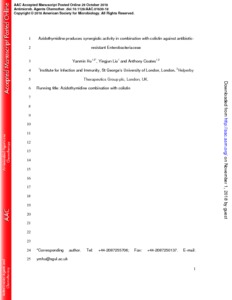Hu, Y; Liu, Y; Coates, A
(2019)
Azidothymidine produces synergistic activity in combination with colistin against antibiotic-resistant Enterobacteriaceae.
Antimicrob Agents Chemother, 63 (1).
e01630-18.
ISSN 1098-6596
https://doi.org/10.1128/AAC.01630-18
SGUL Authors: Hu, Yanmin
![[img]](https://openaccess.sgul.ac.uk/110309/1.hassmallThumbnailVersion/AAC.01630-18.full.pdf)  Preview |
|
PDF
Accepted Version
Available under License ["licenses_description_publisher" not defined].
Download (1MB)
| Preview
|
Abstract
Bacterial infections remain the leading killer worldwide which is worsened by the continuous emergence of antibiotic resistance. In particular, antibiotic-resistant Enterobacteriaceae is prevalent and extremely difficult to treat. Reusing existing drugs and rejuvenating the therapeutic potential of existing antibiotics represent an attractive novel strategy. Azidothymidine (AZT) is an antiretroviral drug which is used in combination with other antivirals to prevent and to treat HIV/AIDS. AZT is also active against Gram-negative bacteria but has not been developed for that purpose. Here we investigated in vitro and in vivo efficacy of AZT in combination with colistin against antibiotic-resistant Enterobacteriaceae including extended-spectrum beta-lactamase (ESBL), New Delhi metallo-beta-lactamase 1 (NDM) or the mobilized colistin resistance (mcr-1) producing strains. Minimum inhibitory concentration was determined using the broth microdilution method. The combinatory effect of AZT and colistin was examined using the checkerboard method and time-kill analysis. A murine peritoneal infection model was used to test the therapeutic effect of the combination of AZT and colistin. Fractional inhibitory concentration index from checkerboard assay demonstrated that AZT synergized with colistin against 61% and 87% of ESBL-producing Escherichia coli and Klebsiella pneumoniae, respectively, 100% of NDM-1-producing strains and 92% of mcr-1 producing E. coli Time-kill analysis demonstrated significant synergistic activities when AZT was combined with colistin. In the murine peritoneal infection model, AZT in combination with colistin showed augmented activities of both drugs in the treatment of NDM-1 K. pneumoniae and mcr-1 E. coli infections. AZT and colistin combination poses a potential to be used coherently to treat antibiotic-resistant Enterobacteriaceae infections.
Statistics
Item downloaded times since 01 Nov 2018.
Actions (login required)
 |
Edit Item |



